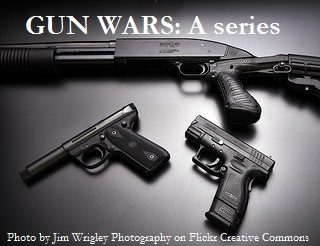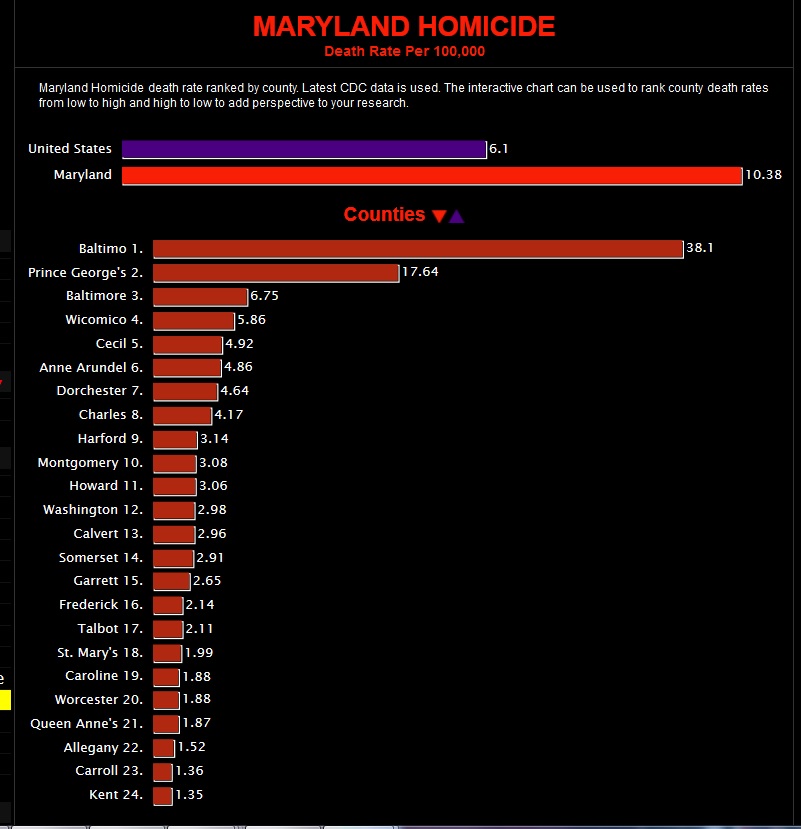Gun Wars: More gun suicides than murders in U.S., about even in Md.
Photo above by Vicious Bites with Flickr Creative Commons License
This report is part of the project titled “Gun Wars: The Struggle Over Rights and Regulation in America,” produced by the Carnegie-Knight News21 initiative, a national investigative reporting project involving top college journalism students across the country and headquartered at the Walter Cronkite School of Journalism and Mass Communication at Arizona State University.
By Carmen Forman and Jacob Byk
News21
 Americans are twice as likely to die from turning guns on themselves as they are to be murdered with one.
Americans are twice as likely to die from turning guns on themselves as they are to be murdered with one.
A national News21 analysis of 2012 data found 18,602 firearm suicides in 44 states compared with about 9,655 firearm homicides in 49 states. That means at least 50 people died per day from firearm suicide; 26 died from firearm homicides.
Gun shops and ranges in areas with high rates of suicide are teaming up with prevention specialists to prevent firearm suicides. Range employees are learning the warning signs of suicide to stop mentally unstable people from getting their hands on guns.
News21 contacted all 50 states seeking suicide data for 2012, the most recent year available, but Delaware, Illinois, Maryland, Massachusetts, Pennsylvania and Rhode Island denied requests for statistics or could not be reached. The FBI received limited homicide data from Illinois and Alabama and none from Florida.
[Editor’s Note: According to the website World Life Expectancy, based on data from the U.S. Centers for Disease Control and Prevention, Maryland had a suicide rate from all causes of 9.05 per 100,000 population, below the national rate of 11.26 per 100,000. Maryland homicide rate from all causes is 10.38 per 100,000, placing it fifth in the nation and much higher than national average of 6.1 per 100,000. Maryland’s high rate is due to the exceptional high rate of murders in Baltimore City and Prince George’s County, most of them from handguns.
Maryland’s firearms death rate is 10.2 per 100,000, ranking it 31st in the nation, which has an average firearms death rate of 10.1.]
Long-term trend
That firearm suicides outnumbered firearm homicides doesn’t surprise Matthew Miller, who studies suicide at the Harvard Injury Control Research Center. Suicide rates have been higher than homicide rates for as long as Miller remembers, but many people still assume they are more likely to die in a mass shooting than they are by shooting themselves, he said.
Living with a gun in the home makes residents more likely to die from suicide, because they’re more likely to attempt suicide using a gun — and with guns, there’s no turning back, Miller said.
The public doesn’t hear about firearm suicides often because of the stigma surrounding suicide and people who kill themselves, he said.
“I think what we see in the media, whether it’s newspapers or television or movies, there have been people shooting at one another with guns, but rarely do you hear information about suicide,” Miller said.
Firearm suicides in the states studied made up 51 percent of the 35,831 total suicides in those states in 2012, News21 found. For the previous five years, firearm suicides made up just under half of all suicides throughout the U.S., according to Centers for Disease Control and Prevention data.
Suicide by firearm has been loosely studied for the past 20 years by the American Association of Suicidology, a research and education organization based in Washington, D.C., that was created in 1968. But most experts concentrate on the motives of suicide victims and not the means people use. Prevention specialists are increasingly studying the link between guns and suicide.
Death and gun ownership: Is there a connection?
Experts say having a gun in the house greatly increases the chance someone will use that gun on themselves. States with high rates of firearm suicide generally have high gun ownership.
[Last year, Capital News Service in Maryland did a story showing the high correlation between gun ownership and suicide. It includes an interactive map by county.]
Alan Berman, former director of the American Association of Suicidology, said there is a direct correlation between gun ownership and death by suicide. Studies show having a gun in the home makes firearm suicide more likely, and can be higher based on gender, age and gun storage.
People choose their method of suicide due to its accessibility, Berman said.
Safe-storage laws are among the few measures suicide analysts agree could help lower firearm suicide rates, because they put a buffer between the mental impulse to end one’s life and the firearms available, Berman said.
“The problem of course is the NRA (National Rifle Association) and their interpretation that any attempt even to talk about safe storage is the beginning of gun control,” Berman said.
Legislation isn’t necessary to promote gun safety, said Don Turner, Nevada Firearms Coalition president.
“As a responsible gun owner, we have the obligation to make sure that our firearms are kept secure and under control, and that we only sell or give firearms to people who are not at risk,” Turner said. “All the time and energy put into limiting access to firearms could be put into improving our mental health system. It would probably yield better results.”
Nationally, firearm suicide rates haven’t changed much over the past 20 years that Berman has studied them. However, some states with prevention programs have had success in lowering rates, he said.
“There are efforts,” Berman said. “But again, they are small-scale efforts relative to a large-scale national issue, which no one has the key to the lock yet.”
Suicide generally stems from a buildup of depression and internal despair, said Cathy Barber, creator of Means Matter — a Harvard research group that studies access to guns or other means of suicide.
It’s not unusual for suicidal people to make several plans or attempts to kill themselves, but experts are noticing a trend of more impulsive suicides with firearms, she said. A survey showed 47 percent of people who attempted suicide did so within 10 minutes of thinking about it, she said.
“For the person who is going from 0 to 60 in a few seconds, you don’t want that person to have access to something that could really quickly kill them,” Barber said. “You want to try to build some delay in them being able to get their hands on something that could kill them.”
Gun owners have higher rates of suicide than non-gun owners, but they don’t have higher rates of attempts, according to a study on which Barber worked. They don’t have higher rates of mental illness and aren’t more likely to kill themselves. They are just more likely to use a more final means for suicide, she said.
Voluntarily relinquishing firearms to a friend or loved one during times of depression, high stress or mental anguish removes the temptation of turning to a gun when someone might be contemplating suicide, Barber said.
(The rest of the story — another 1,700 words– focuses on Nevada and efforts there by public officials, citizens and gun store owners to cut down on its high rate of suicides by firearms.)
Carmen Forman is an Ethics and Excellence in Journalism Foundation News21 Fellow.

MarylandReporter.com is a daily news website produced by journalists committed to making state government as open, transparent, accountable and responsive as possible – in deed, not just in promise. We believe the people who pay for this government are entitled to have their money spent in an efficient and effective way, and that they are entitled to keep as much of their hard-earned dollars as they possibly can.


